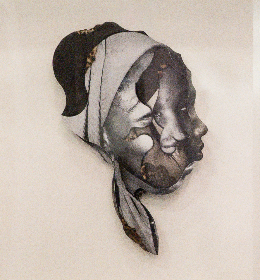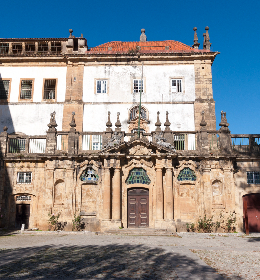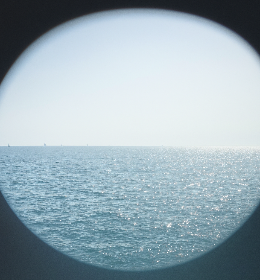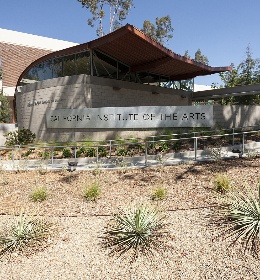I recently visited Ari Kupsus Gallery in Budapest where the work of Hungarian artist Patrick Tayler intermingles with antique furniture, creating scenarios in space as impromptu installations. “I used to stare in amazement at the windows of toy stores as a child. I think it is possible to ogle at something until you own it, it becomes a part of your personality: it’s a wonderful way of stepping out of consumption culture,” explains Tayler in reference to the inspiration for his still life paintings. His works depict the wonders of childhood: the cakes, the candies, their bright colors, as we have often seen in the windows of novelty stores. These paintings defy the element of time, frozen, and fixed in fluorescent light, in the shop windows of our childhood.
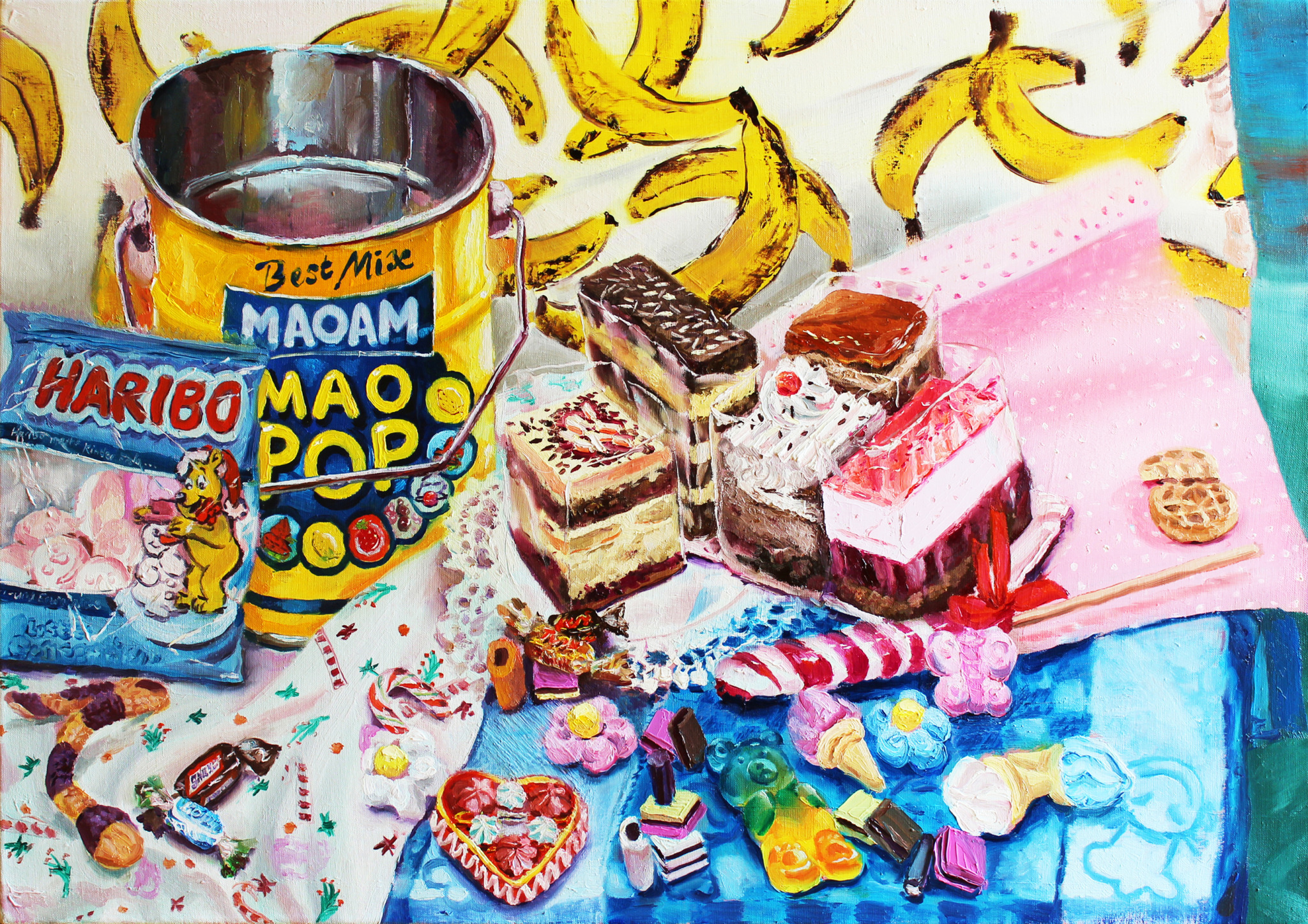
Patrick Tayler: Mao-Pop, 2020, oil on canvas, 70.100 cm | Photo courtesy of the artist
He explains the fixed notion of time in these works: “The point of the day becomes irrelevant because it is exactly stepping out of – and at the same time into – reality that is central in my artistic practice. The fluorescent light fixture of intense attention is what isolates my objects from their surroundings, creating floating islands of color, form and shape.”
Indeed, they are as islands; the reference to outside space is irrelevant, they are in themselves as unique settings, stories set or actors ready to be set in motion. We are poised to unwrap them, eat them, interact. Our position and necessity is implicit, we don’t doubt these are here for us. We remember this undeniable feeling of entitlement that children feel: that sweets, candies, are made for us, to consume, to enjoy, to speed up our experience and wear us out.
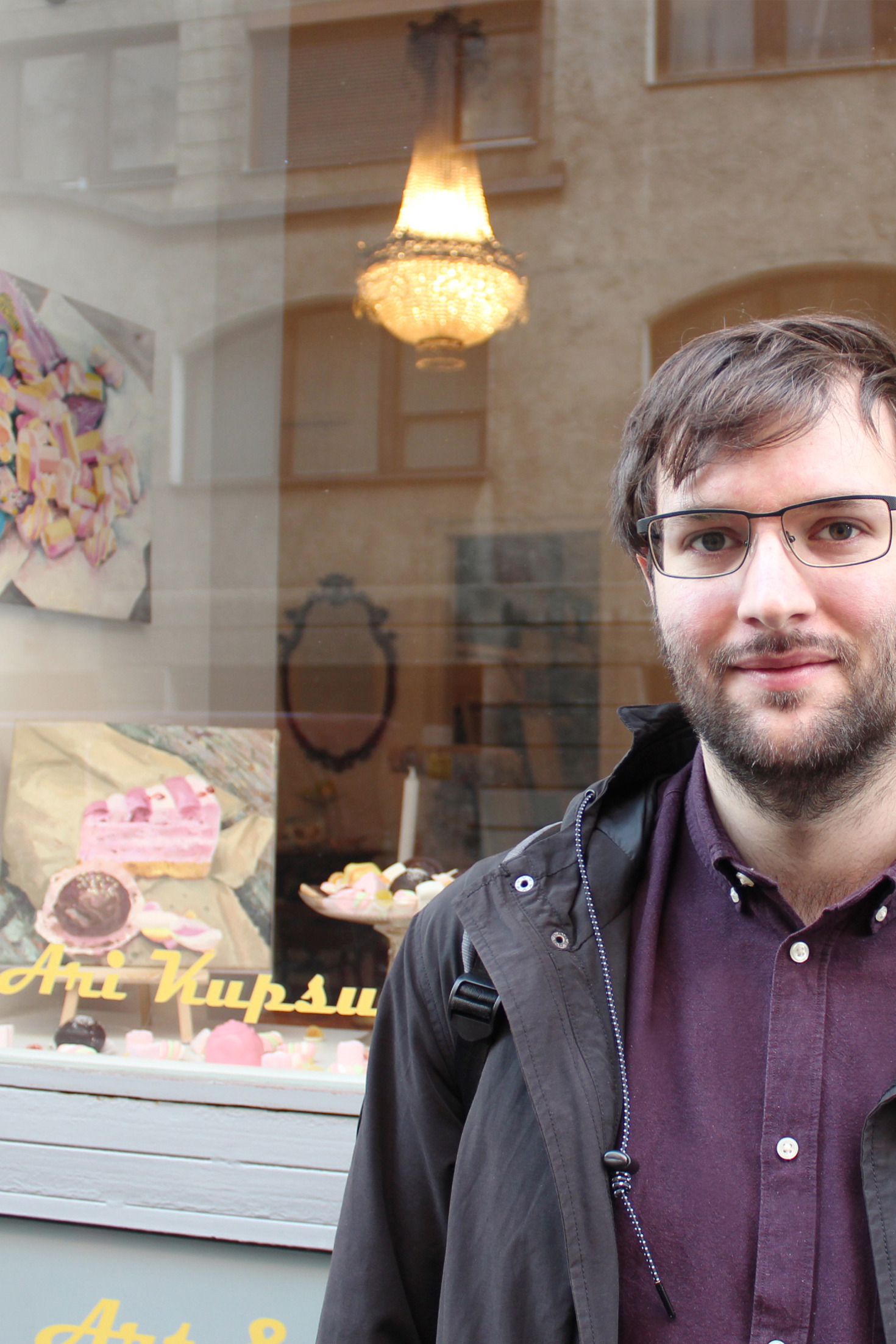
Patrick Tayler in front of Ari Kupsus Gallery in Budapest, 2020 | Photo courtesy of the artist
“Of course, sugar is a super-light drug: a cake is a bite-sized portal compared to the Huxleyesque Doors of Perception. Painting is one of the most intense normcore platforms for reality becoming weird. I think reality actually doesn’t like the sensible shoes of realism. There has to be some room for the toes of imagination. Instead of Matisse’s armchair, I want my paintings to be child-friendly rollercoasters for the exhausted mind. The process of painting is also an exploration of subjectivity. You could interpret it as an entertaining form of self-reflection that becomes public, like the unleashed secrets of a personal diary,” Tayler explains in detail.
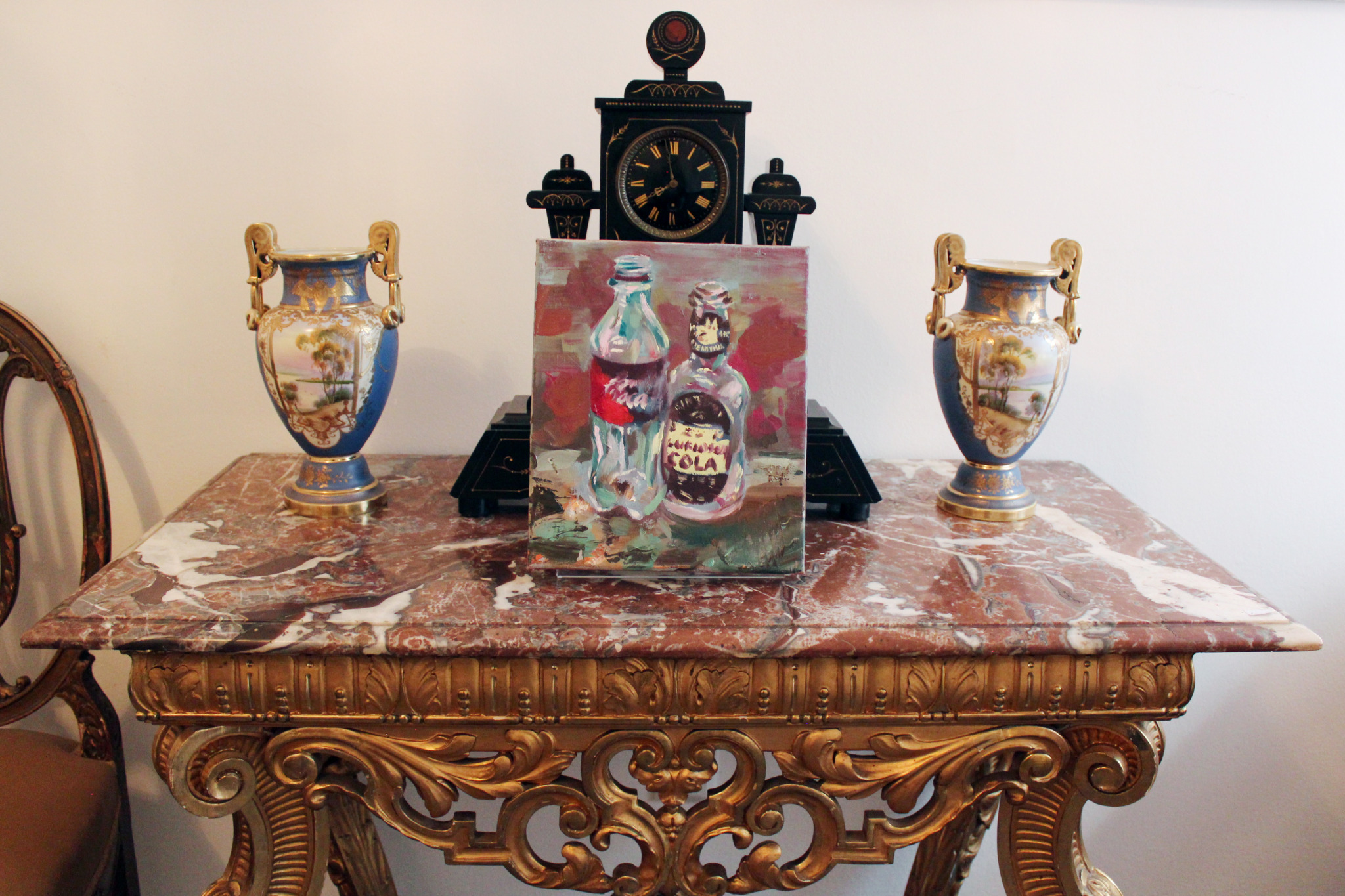
Installation Shot, Its a Matter of Taste, Ari Kupsus Gallery, Budapest, Hungary, 2020 | Photo courtesy of the artist
Tayler continues with what might be perceived as a darker interpretation: ”I think still-life painting is rooted in the situation when we are forced to wait for somebody or at least for something to happen. We cannot help perceiving still-lives in front of us, and according to Jean Baudrillard, we mourn ourselves through the objects around us. Aimless gazing turns on itself, resulting in a weird short circuit: a kind of self-portrait.” Tayler’s reference to mourning does not seem to be macabre, but rather the point of growth, how we accept the stages of life, their passing and the new things that arrive, while at the same time we can fixate, observe, be caught up in the moment through his paintings. He remarks how the work itself, the point of view, the gaze, is revelatory, a form of self-portrait. The paintings capture our attention as if we have just arrived, taken off our coats, and sat down for a moment of captivation, the splendor of color and anticipated consumption enveloped in our perception. But his reference to mourning cannot be denied; perhaps there is something more to see, to observe, to reflect upon. Time creeps up on us, intermingles with the novelties we collect, with the sweets we consume, with our indulgences and our possessions.

Patrick Tayler: Cookie Ruins, 2019, oil on canvas, 24.30 cm | Photo courtesy of the artist
“I really love a sentence by the Japanese author Haruki Murakami in his book, The Wind-Up Bird Chronicle: ’Spending plenty of time on something can be the most sophisticated form of revenge.’ The undivided attention – that one needs to be able to look at a painting – is a high-end luxury item,” cites Tayler.
The element of desire infused into the works is an evident ploy, a way to draw us into something more, a deeper conception: “In my latest series titled ”Dolce”, which depicts sweets and other delicacies, I offer the viewer something they might desire. But like the sugar-powdered Turkish delight in the first book of Narnia, it acts as a trap. By looking at the cakes in my paintings, one is drawn to the circus show of oil paint pretending to be fondant, chocolate, marzipan and other luscious materials. Of course, there are underlying themes to all of my pictures: topics such as naivety, cuteness, regression and nostalgia, to name a few. These lofty ideas can provide an amazing soundtrack to seemingly undeserving details, like the exact shade of a pink troll toy or the precise tone of hardened whipped cream,” explains Tayler.
When asked to explain further his references and influences, he says, “I am also drawn to the gravity in Charles Bell’s lightening-sharp gumballs and pinballs, the present tense nostalgia of Martin Parr’s food photography and – to go way back in time – the intricate, radiant beauty of 17th-century Dutch paintings.“
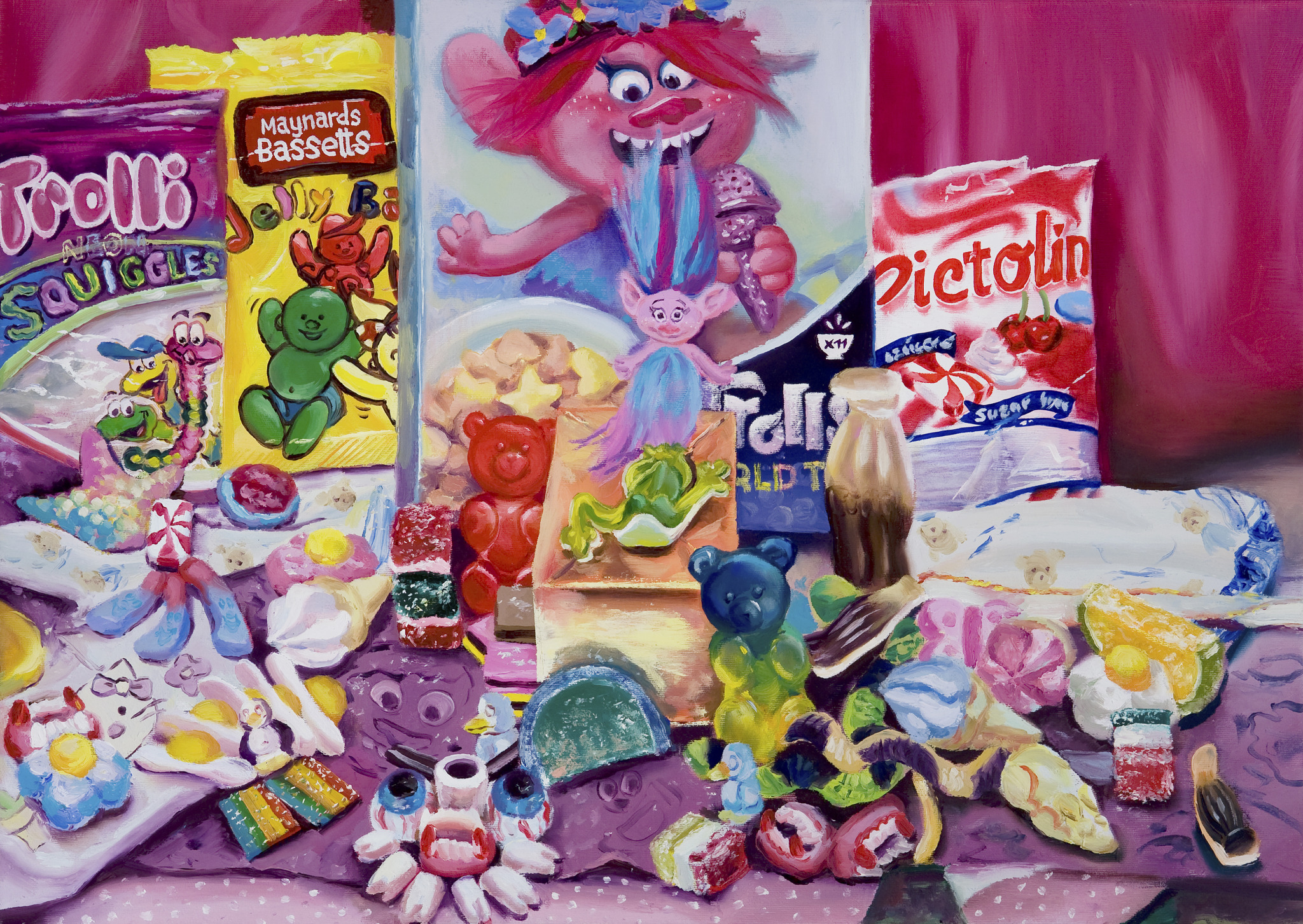
Patrick Tayler: All Eyes On Us, 2020, oil on canvas, 50×70 cm | Photo: Mihály Dömötör
The contemplations of these cakes, cookies, and sweets often brings me to a state of nostalgia, as if in the vaporous cloud of sugar and its splendid rush of energy. The holidays bring to us an inundation of these sensations. The connections we make to the colors, tastes, textures, and desire for these items, which Tayler paints with such fluidity and luxuriant textures, is an undeniable evidence to the magnetic allure of memory and association, both human essentials throughout history.
Tayler emphasizes this allure in terms of comfort and in relation to the creation of the work itself: “painting is my Hygge. I would compare this creative zone to the experience of a headache, which kind of pops up once in a while, but feels like the uninterrupted life of an alter ego, living according to a very different set of rules (squinting, staring, blinking).” Yes, I think this sums up this year succinctly, like the rush of pain in one’s forehead if you eat ice cream too quickly. Here, Tayler shows us these moments in distinct vignettes, scenarios of sugar, placements, arrangements, and ways of creating sense from nonsensical times.
Anne Murray





